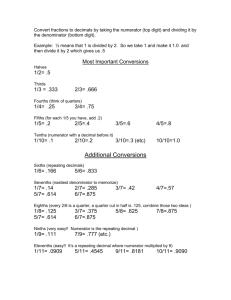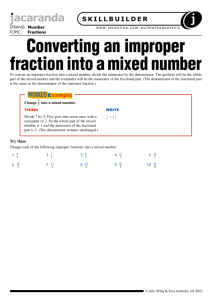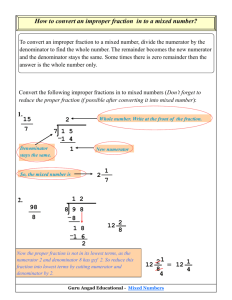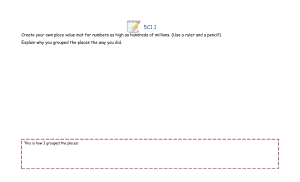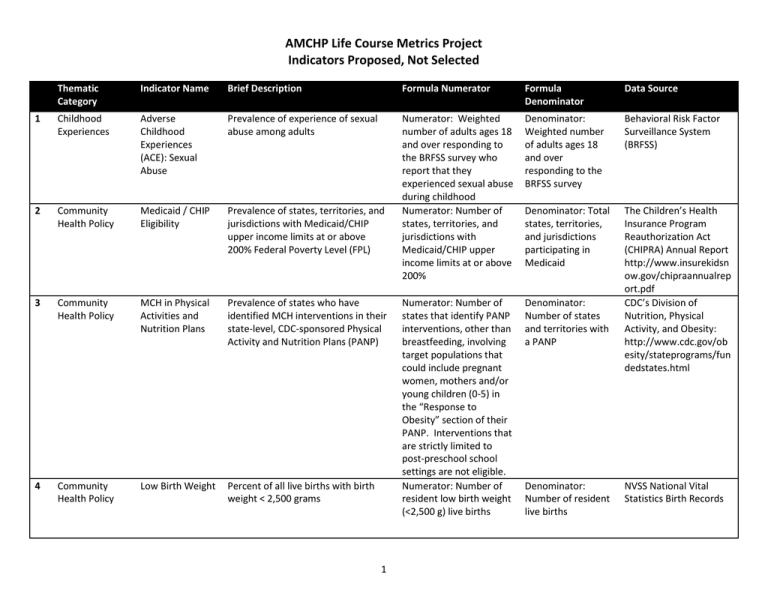
AMCHP Life Course Metrics Project
Indicators Proposed, Not Selected
Thematic
Category
Indicator Name
Brief Description
Formula Numerator
Formula
Denominator
Data Source
1
Childhood
Experiences
Adverse
Childhood
Experiences
(ACE): Sexual
Abuse
Prevalence of experience of sexual
abuse among adults
Denominator:
Weighted number
of adults ages 18
and over
responding to the
BRFSS survey
Behavioral Risk Factor
Surveillance System
(BRFSS)
2
Community
Health Policy
Medicaid / CHIP
Eligibility
Prevalence of states, territories, and
jurisdictions with Medicaid/CHIP
upper income limits at or above
200% Federal Poverty Level (FPL)
Numerator: Weighted
number of adults ages 18
and over responding to
the BRFSS survey who
report that they
experienced sexual abuse
during childhood
Numerator: Number of
states, territories, and
jurisdictions with
Medicaid/CHIP upper
income limits at or above
200%
Denominator: Total
states, territories,
and jurisdictions
participating in
Medicaid
3
Community
Health Policy
MCH in Physical
Activities and
Nutrition Plans
Prevalence of states who have
identified MCH interventions in their
state-level, CDC-sponsored Physical
Activity and Nutrition Plans (PANP)
Denominator:
Number of states
and territories with
a PANP
4
Community
Health Policy
Low Birth Weight
Percent of all live births with birth
weight < 2,500 grams
Numerator: Number of
states that identify PANP
interventions, other than
breastfeeding, involving
target populations that
could include pregnant
women, mothers and/or
young children (0-5) in
the “Response to
Obesity” section of their
PANP. Interventions that
are strictly limited to
post-preschool school
settings are not eligible.
Numerator: Number of
resident low birth weight
(<2,500 g) live births
The Children’s Health
Insurance Program
Reauthorization Act
(CHIPRA) Annual Report
http://www.insurekidsn
ow.gov/chipraannualrep
ort.pdf
CDC’s Division of
Nutrition, Physical
Activity, and Obesity:
http://www.cdc.gov/ob
esity/stateprograms/fun
dedstates.html
1
Denominator:
Number of resident
live births
NVSS National Vital
Statistics Birth Records
Thematic
Category
Indicator Name
Brief Description
Formula Numerator
5
Community
Health Policy
Infant Mortality
Infant mortality rate per 1,000 live
births
Numerator: Total
Denominator: Total
number of infant deaths
live births
(or deaths to children less
than 1 year/365 days of
age)
6
Community
Health Policy
PregnancyRelated Death
Pregnancy-related death ratio per
100,000 total live births
Denominator: Total
resident live births
7
Community
Health Policy
Medicaid
Expansion
The prevalence of states
implementing the 2014 Medicaid
expansion
Numerator: Total
resident pregnancyrelated deaths
Numerator: Number of
states/territories
implementing expansion
8
Community
Health Policy
Neighborhood
Amenities
Percent of children ages 0 to 17 years
with access to neighborhood
amenities (sidewalks, parks,
recreation centers, libraries).
Denominator:
Number of children
ages 0 to 17 years
9
Community
Safety
Parents
Perceived Safety
of Children in
School
Percent of adolescents 6-17 years
whose parents consider them to be
safe at school
10
Early Life
Services
Child Care
Quality Rating
and
Improvement
Prevalence of states implementing a
child care Quality Rating System
(QRS) or Quality Rating &
Improvement System (QRIS)
Numerator: Number of
neighborhood amenities
(sidewalks, parks,
recreation centers, or
libraries) available to
children ages 0-17 years
Numerator – Number of
adolescents aged 6 to 17
years whose parents
consider them to be safe
at school
Numerator: Number of
states, territories, and
jurisdictions
implementing one or
more QRS included in the
Office of Planning,
Research and Evaluation
(DHHS/ACF)
Compendium of Quality
2
Formula
Denominator
Denominator: Total
States and
territories
Denominator –
Number of
adolescents aged 6
to 17 years enrolled
in school
Denominator: Total
states, territories,
and jurisdictions
Data Source
Death and birth records
from state vital statistics
offices and the National
Center of Health
Statistics via the
National Vital Statistics
System
Pregnancy Mortality
Surveillance System
(PMSS)
Track until 2014 – The
Advisory Board
Company
http://www.advisory.co
m/DailyBriefing/2012/11/09/Me
dicaidMap
The National Survey of
Children’s Health (NSCH)
and the National Survey
of Children with Special
Health Care Needs
(NSCSHCN)
National Survey of
Children’s Health
Child Care Quality Rating
System (QRS)
Assessment:
Compendium of Quality
Rating Systems and
Evaluations
https://www.acf.hhs.go
v/sites/default/files/opr
e/qrs_compendium_fina
Thematic
Category
Indicator Name
Brief Description
Formula Numerator
Formula
Denominator
Rating Systems and
Evaluations
11
Early Life
Services
Children are
Screened Early
and Continuously
for Special Health
Care Needs
Percent of children with special
health care needs (CSHCN) who
received at least one preventive
medical and dental visit in the past
year
Numerator: Children 0-17
years who had at least 1
preventive medical visit
and at least 1 preventive
dental visit in the past 12
months. Children under 1
year old were excluded
from needing preventive
dental care. Therefore,
any child under 12
months of age only
needed to respond with 1
or more preventive
medical visits to meet
this indicator.
Respondents with
answers of don't know or
refused to either item
were set to missing
3
Data Source
l.pdf
Denominator: all
children 0-17 years
National Survey of
Children with Special
Health Care Needs
12
13
Thematic
Category
Indicator Name
Brief Description
Formula Numerator
Formula
Denominator
Data Source
Early Life
Services
Early Childhood
Accreditation
Percentage of early childhood
centers that are accredited
Numerator: Number of
Early Childhood programs
accredited by the
National Association for
the Education of Young
Children (NAEYC)
Denominator: Total
licensed childcare
centers
Numerator: National
Association for the
Education of Young
Children
http://oldweb.naeyc.org
/academy/summary/cen
ter_summary.asp
or search by city, state,
address, program name
at:
http://www.naeyc.org/a
cademy/accreditation/s
earch
Economic
Experiences
Housing Cost
Burden
Percent of households paying more
than 50% of their income towards
housing costs
4
Numerator: # of
households that are
paying more than 50% of
their household income
on housing costs (severe
housing cost burden)
***Note some team
members suggested
keeping 30% or more (vs.
50%)
Denominator: total
# of households
Denominator: Child
Care Aware of America
(formally NACCRA
National Association
of Child Care Resources
and Referrals Agencies)
http://www.naccrra.org
/node/2495 State data
are available by clicking
on individual states,
then referencing the
state Fact Sheet.
American Community
Survey (ACS), US Census
Thematic
Category
Indicator Name
Brief Description
Formula Numerator
Formula
Denominator
Data Source
14
Economic
Experiences
Gini Index of
Income
Inequality
Numerator: Gini
coefficient (0 to 1- 0
indicates no inequality, 1
indicates complete
inequality)
*pre-calculated by ACS
Denominator: N/A
(pre-calculated by
ACS)
U.S. Census Bureau,
American Community
Survey (ACS)
15
Environmental
Health
Air PollutionParticulates
The Gini index of income inequality
measures the dispersion of the
household income distribution in a
population. The Gini index varies
from zero to 1. Here, zero
corresponds to perfect income
equality (i.e. everyone has the same
income) and 1
correspond
The average exposure of the general
public to particulate matter of 2.5
microns or less in size (PM2.5).
Numerator: The average
exposure of the general
public to particulate
matter of 2.5 microns or
less in size (PM2.5).
United Health
Foundation, America’s
Health Rankings
http://www.americashe
althrankings.org/ALL/air
/2012
16
Family & Social
Wellbeing
School Absence
Percent fourth-graders absent from
school 5 or more days in the past
month. Good predictor of academic
success
Numerator: 4th-graders
absent 5 or more days in
the past month
Denominator:
Exposure levels are
weighted to
represent the
population in the
specific
geographical region.
Denominator: all
4th-graders
17
Family & Social
Wellbeing
Adult Asthma
Percent adults who currently have
asthma
Numerator: Total current
asthma cases among
adult population ≥18
Denominator: Total
adult population
≥18
Behavioral Risk Factor
Surveillance System
18
Family & Social
Wellbeing
Literacy—Child
Percent of children who were read to
by a family member every day
Denominator:
Children ages 0-5
(weighted)
National Survey of
Children's Health (NSCH)
19
Family & Social
Wellbeing
Physical Inactivity Prevalence of children and adults not
meeting physical activity state policy
standards per week
Numerator: Days during
the previous week on
which family members
read stories to young
children: none; 1-3 days;
4-6 days; every day
Numerator: Number of
children and adults not
meeting public health
policy standards for
physical activity.
Denominator:
Number of children
and adults included
in the identified
data systems used
to measure this
indicator.
a. Youth Behavior Risk
Surveillance (YRBSS)
b. National Survey of
Children’s Health (NSCH)
c. Behavioral Risk Factor
Surveillance System
(BRFSS)
5
National Center for
Education Statistics
Thematic
Category
Indicator Name
Brief Description
Formula Numerator
Formula
Denominator
Data Source
20
Family & Social
Wellbeing
Chronic
Stress/Resilience
Regions and metropolitan area
capacity for resilience, measure by
the Resilience Capacity Index
Numerator:
Regions/Metros with
very high resilience
capacity
Denominator: Total
number of
regions/metros
21
Family & Social
Wellbeing
PregnancyInduced
Hypertension
Percent of adult women with
diagnosed hypertension during
pregnancy
Numerator: Total number
of women diagnosed
with hypertension during
pregnancy
Denominator: Total
number of pregnant
women
22
Family & Social
Wellbeing
Injury
Physical/Sexual
Abuse
Number of rapes or sexual assaults
per 1,000 females age 12 and older
Denominator: Per
1,000 females age
12 and older
23
Family & Social
Wellbeing
Single ParentHeaded
Households
Percentage of children that live in
household headed by single parent
(by race/ethnicity, child's age [<6 and
6-17 years])
24
Family & Social
Wellbeing
Foster Care
Rate of children 0 to 17 in foster care
per 1,000
Numerator: Number of
females age 12 and older
who reported being
raped or sexually
assaulted
Numerator: Single
parent households with
related children under 18
years of age (<6 and 617)
Numerator: Number of
children 0 to 17 in foster
care included in the data
system used to measure
this indicator.
Building Resilient
Regions (BRR) Institute
of Government Studies,
The University of
California Berkley
http://brr.berkeley.edu/
rci/
Vital Stats, National Vital
Statistics System (NVSS),
and the Pregnancy Risk
Assessment Monitoring
System (PRAMS)
Bureau of Justice
Statistics (BJS) National
Crime and Victimization
Survey (NCVS)
25
Health Care
Access and
Quality
Children With
Adequate Health
Insurance
Coverage
Percent of children who have
adequate insurance coverage
Numerator: Child has
adequate health
insurance coverage;
(Alternatively, look at
inadequate: Child has
inadequate health
insurance coverage or
currently uninsured)
6
Denominator: Total
household that have
related children
under 18 years of
age (<6 and 6-17)
Denominator:
Number of children
age 0 to 17 in the
state or
geographical unit of
interest
Denominator:
Children age 0-17
years
American Community
Survey (ACS)
http://www.census.gov/
acs/www/
Adoption and Foster
Care Analysis and
Reporting System
(AFCARS)
National Survey of
Children’s Health (NSCH)
Thematic
Category
Indicator Name
Brief Description
Formula Numerator
Formula
Denominator
Data Source
26
Health Care
Access and
Quality
Early and
Adequate
Prenatal Care
The proportion of pregnant women
who receive early and adequate
prenatal care.
Denominator: 1)
The number of live
births that occurred
in the calendar year
and 2) the number
of live births in a
calendar year
Vital records –
certificates of live birth –
NCHS. States can also
use their own vital
records data that may
be more timely than
that available via NCHS.
27
Health Care
Access and
Quality
Preconception
Health
Counseling
Percent of women who have
discussed preconception health with
a health care worker prior to
pregnancy.
Numerator: 1) The
number of women who
initiated PNC in the 1st
trimester in a calendar
year and 2) the number
of women who received
adequate PNC based on
the Kotelchuck index in a
calendar year
Numerator – Number of
women who reported
that they obtained
preconception counseling
Pregnancy Risk
Assessment Monitoring
System (PRAMS)
28
Health Care
Access and
Quality
Health Care
Utilization - Adult
Percent of adults who report they
have had a preventive health visit in
the past year.
Denominator –
Total number of
women of
childbearing age
surveyed
Denominator: Adult
population (18+
years)
29
Health Care
Access and
Quality
Transition
Services for
Youth with
Special Health
Care Needs
Youth with special health care needs
receive services necessary for a
successful transition to adult life.
Denominator: All
Children with
special health care
needs age 12-17
years
National Survey of
Children with Special
Health Care Needs
7
Numerator: Number of
adults (18+ years) who
reported having had a
routine health checkup
within the past year
Numerator: CSHCN age
12-17 years whose
doctors usually/always
encourage increasing
responsibility for selfcare and (when needed)
have discussed
transitioning to adult
health care, changing
health care needs, and
how to maintain
insurance coverage;
CSHCN age 12-17 who
did not achieve this
outcome.
Behavioral Risk Factor
Surveillance System
(BRFSS
Thematic
Category
Indicator Name
Brief Description
Formula Numerator
Formula
Denominator
Data Source
30
Mental Health
Depression
(Suicide AttemptTeen)
Percent of 9th-12th graders who
have seriously considered or have
attempted to commit suicide
Numerator: Teens
reporting seriously
considering or attempted
suicide
Youth Risk Behavior
Surveillance System
(YRBSS)
31
Mental Health
Mental Health
Screening Juvenile Facilities
The proportion of juvenile residential
facilities that screen admissions for
mental health problems.
32
Nutrition
Household Food
Security - SNAP
Recipients
Percent of families with children
receiving SNAP benefits in a given
state compared to percent of families
with children eligible for SNAP
benefits
Numerator: Number of
juvenile residential
facilities that screen all
admitted clients for
mental health problems
Numerator: # of families
with children receiving
SNAP benefits
Denominator: All
teens completing
the YRBS (9-12th) in
states that
participate in YRBS)
Denominator:
Number of juvenile
residential facilities
Denominator: # of
families with
children below
130% Federal
Poverty Line
United States
Department of
Agriculture (USDA)
Economic Research
Survey (ERS)
33
Public Health
Capacity
Data Capacity to
capture adverse
childhood events
Prevalence of states collecting
Adverse Childhood Events (ACES)
data through the Behavioral Risk
Factor Surveillance System
Numerator: Number of
states/territories with
ACES module on the
annual BRFSS
Denominator: 50
states, the District
of Columbia, Puerto
Rico, the U.S. Virgin
Islands, and Guam
34
Public Health
Capacity
Child
Maltreatment
(ratio of CPS
investigation and
alternative
response
workers to child
population)
Ratio of CPS Investigation and
Alternative Response workers to
child population
Numerator: Number of
CPS investigation and
alternative response
workers
Denominator: Child
population as
defined in ACF Child
Maltreatment
report.
CDC Behavior Risk
Factor Surveillance
System (BRFSS) Website
(Use of Multiple
Questionnaire Data) :
http://www.cdc.gov/brf
ss/technical_infodata/su
rveydata/2010/2010_m
ultiple.htm
Administration for
Children and Families
Children’s Bureau: Child
Maltreatment 2011.
http://www.acf.hhs.gov
/programs/cb/researchdatatechnology/statisticsresearch/childmaltreatment
8
Juvenile Residential
Facilities Census (JFRC),
DOJ, OJJDP.
Thematic
Category
Indicator Name
Brief Description
Formula Numerator
Formula
Denominator
Data Source
35
Reproductive
Life Experiences
Abortion Access
Access to safe, legal abortions using
the number of abortion care
providers within each county.
Numerator: # of abortion
care providers
Denominator:
women age 15-44
by county
36
Reproductive
Life Experiences
STI-Chlamydia
(all)
Chlamydia rate per 100,000 total
population
Numerator: Total
reported Chlamydia cases
in the population
Denominator: Total
population
37
Reproductive
Life Experiences
Preconception
Risk Factor Score
Percent of women with 2 or more
risk factors based on at-risk drinking,
smoking, obesity, diabetes and
frequent mental stress (Denny et al.,
J. Women's Health 2012)
Numerator: Weighted
number of non-pregnant
women age 18-44
responding to the
Behavioral Risk Factor
Surveillance System
(BRFSS) survey that they
had two or more risk
factors (based on: at-risk
drinking, smoking,
obesity, diabetes, and
frequent mental distress)
Denominator:
Weighted number
of non-pregnant
women age 18-44
responding to the
BRFSS survey
Jones RK and Kooistra,
K., Abortion Incidence
and Access to Services in
the United States, 2008,
Perspectives on Sexual
and Reproductive
Health, 2011, 43(1).
Guttmacher Institute
(data collected every 4
years), planned
parenthood, National
Abortion Federation
Population data from:
Census
CDC's National Center
for HIV/AIDS, Viral
Hepatitis, STD, and TB
Prevention (NCHHSTP)
Atlas
Behavioral Risk Factor
Surveillance Survey
(BRFSS)
9
Thematic
Category
Indicator Name
Brief Description
Formula Numerator
Formula
Denominator
Data Source
38
Reproductive
Life Experiences
Birth Spacing /
Inter-pregnancy
Interval
Percentage of live births conceived
within 18 months of a previous birth
Denominator: All
women in states
and territories who
have implemented
the Revised 2003
birth certificate who
reported having a
previous live birth.
Certificate of Live Birth National Vital Statistics
System (NVSS)
39
Reproductive
Life Experiences
Maternal Age
Both maternal age and maternal age
at first birth (<=19, 20-24, and 25+)
were assessed for face validity,
predictive power, wide availability,
and malleability and inclusion in the
Index. The latter maternal age
variable was chosen over maternal
age as “it reflects concern about
delaying the first birth over the
mother’s age at any given focal
child’s birth”.
Numerator: Women in
states and territories who
have implemented the
Revised 2003 birth
certificate who had less
than 18 months between
their previous live birth
and the start of the
pregnancy resulting in
the most recent live
birth.
Numerator: Median
Mother’s Age (years)
Denominator:
Primiparous women
(women who have
only given birth to
one child)delivering
a live birth
Birth data set, which is
part of the National Vital
Statistics System (NVSS).
NVSS contains all live
births reported in the
United States. The birth
data set is the primary
data set for analyzing
birth trends and
patterns in the United
States. Birth data sets
are available from Vital
Stats Online and
VitalStats.
40
Social Capital &
Community
Engagement,
Social Cohesion
Residential
Mobility for
Children
Percent of children who live in the
same house as they did a year ago
Numerator: Children (1
to 4 yrs., 5 - 17 yrs) who
live in the same house as
they did a year ago
Denominator: Total
children (1-4 yrs, 517 yrs)
American Community
Survey, variable
#B07001
10
Thematic
Category
Indicator Name
Brief Description
Formula Numerator
Formula
Denominator
Data Source
41
Social Capital &
Community
Engagement,
Social Cohesion
Adolescent Social
Connectedness
Measure of social connectedness: Is
there at least one teacher or other
adult in this school that you can talk
to if you have a problem?; and Can
you talk with at least one of your
parents or other adult family
members about things that are
important to you?
Denominator: Total
number (weighted)
of respondents
National Survey of
Children’s Health
http://www.childhealth
data.org/browse/survey
/results?q=641
42
Social Capital &
Community
Engagement,
Social Cohesion
Social Capital &
Community
Engagement,
Social Cohesion
Percent Teens
Not Attending
School and Not
Working
Arrests
Associated with poor health and
economic outcomes
Numerator: The number
(weighted) of parents of
children age 6-17 who
reported being contacted
by the child’s school
about children’s
problems at the school.
2007 - (K7Q04)http://www.childhealthd
ata.org/browse/survey/r
esults?q=939
2010/11- How often did
school contact parents
about children's
problems at school?
(S7Q04 )
http://www.childhealthd
ata.org/browse/survey/r
esults?q=641
Numerator: Youth, ages
16-19 not enrolled in
school, and not employed
Denominator: All
youth, ages 16-19
American Community
Survey (ACS), US Census
Numerator: Number of
global arrests reported:
all offenses
1) Number of arrests
(adults 18+)
2) Number of arrests
(children < 18) / juvenile
arrests
3) Number of children in
public schools with in or
out of school suspensions
Denominator:
population covered
in arrest report and
Department of
Education data
source
1) Total adult
population
2) Total juvenile
population
3) Total student
population in public
schools
Bureau of Justice
Statistics. Based on FBI’s
Age, Sex, and Race
Summarized Yearly
Arrest Master Files
(indicators 1 &2);
Department of
Education (DOE) Civil
Rights Data Collection
(indicator 3) http://ocrdata.ed.gov/
43
Arrests per 1,000 persons : all
offenses
11
44
Thematic
Category
Indicator Name
Brief Description
Formula Numerator
Social Capital &
Community
Engagement,
Social Cohesion
Education Index
of Concentration
at the Extremes
(ICE), by
Community
Percent of counties with high
educational inequality, also an
indicator of social capital
Numerator: # of residents Denominator: total
in a census tract with a
population x
college degree as an
100,000
indicator of advantage,
calculated as:
ICE=(College graduates–
No High School)
12
Formula
Denominator
Data Source
American Community
Survey 2011, U.S.
Bureau of the Census


